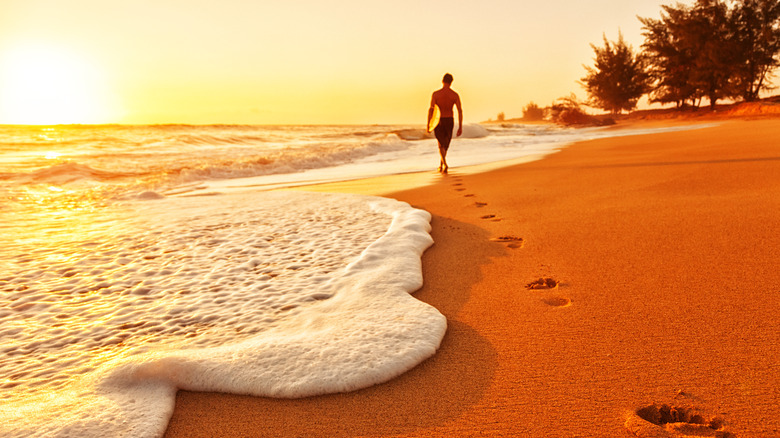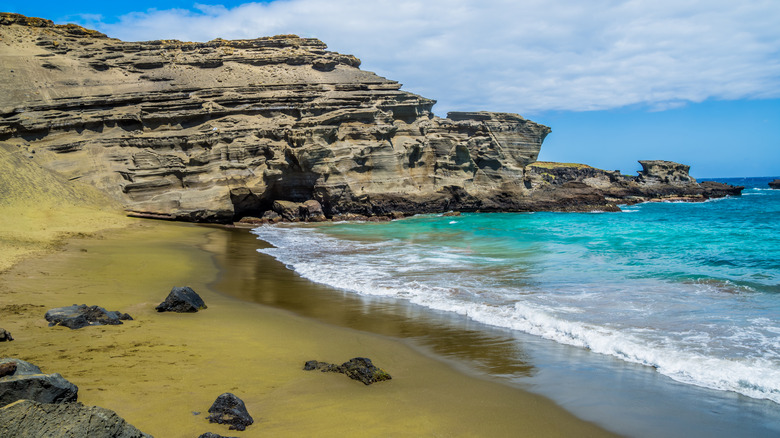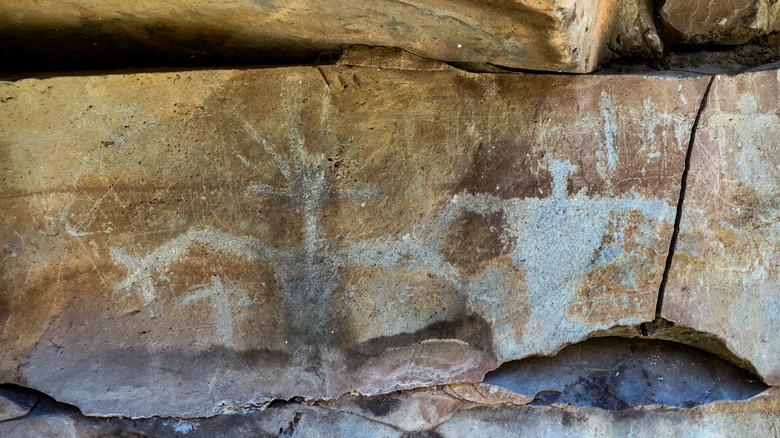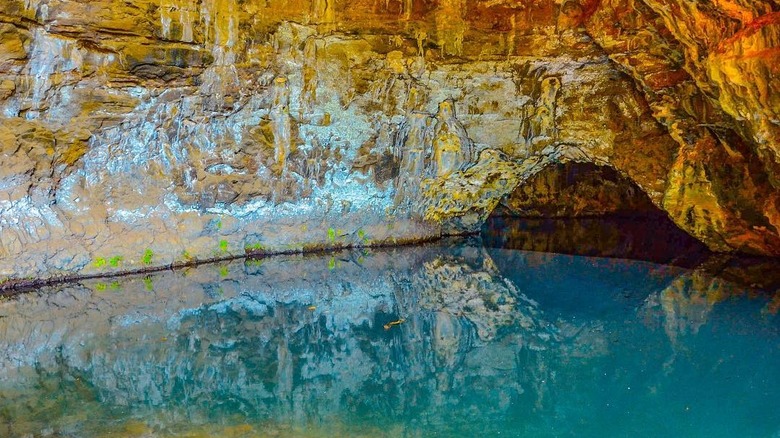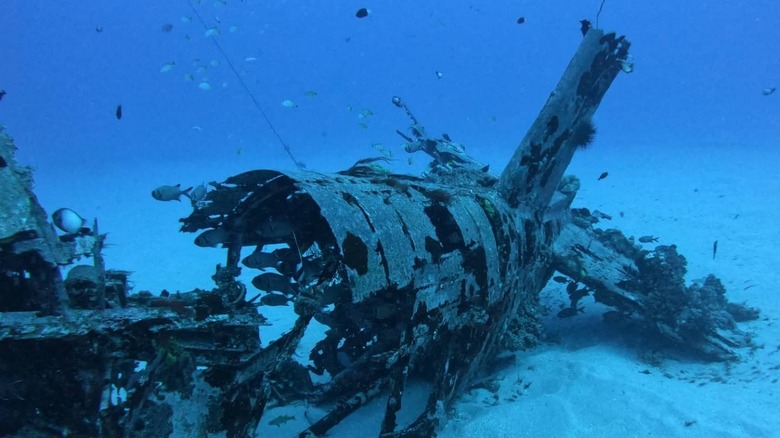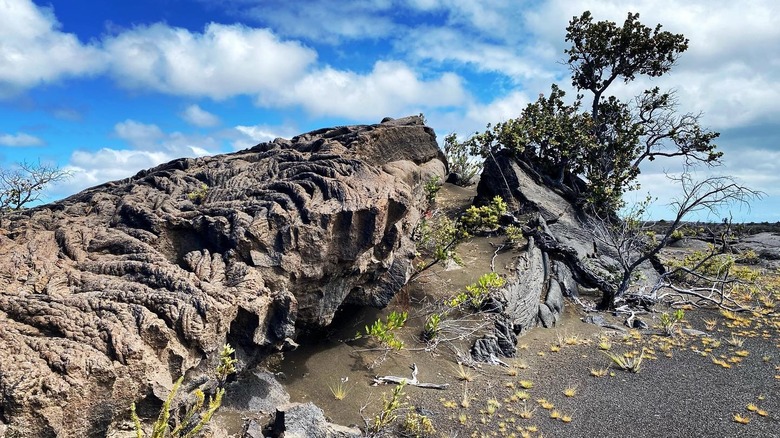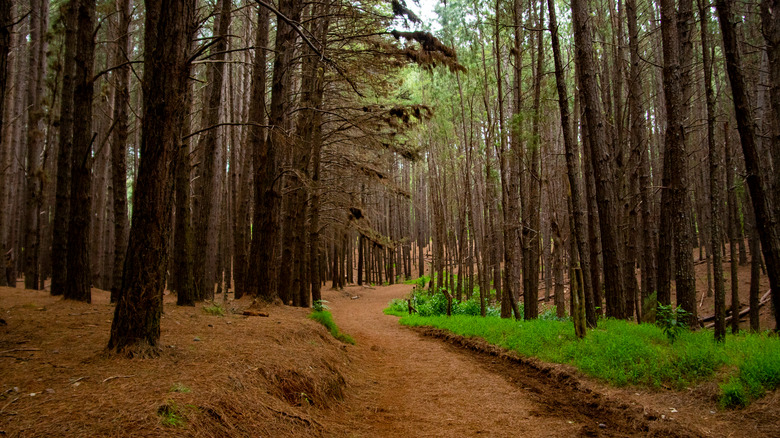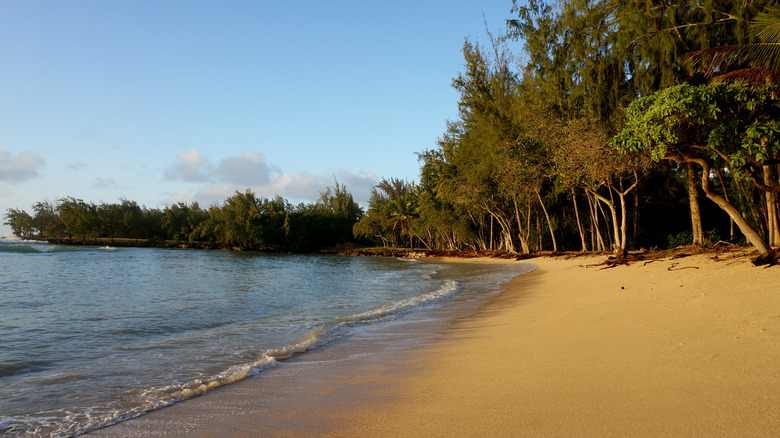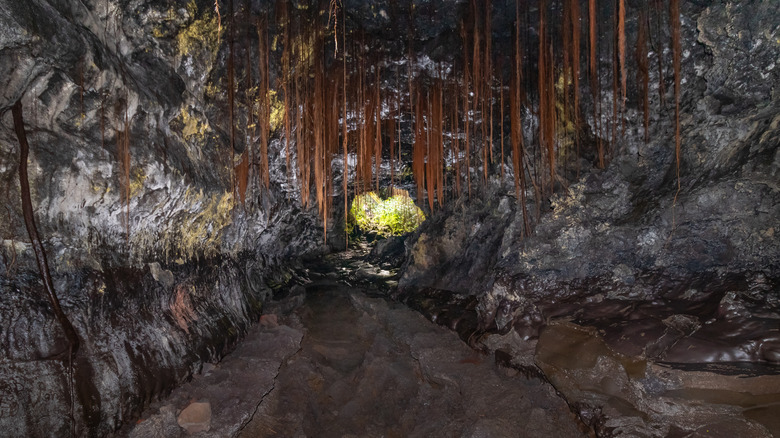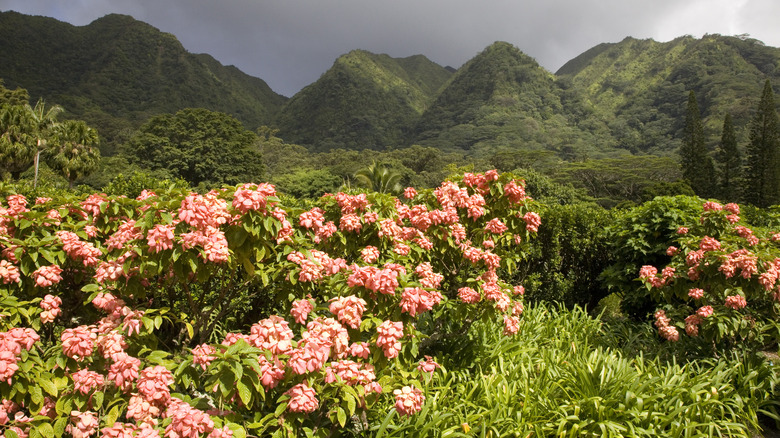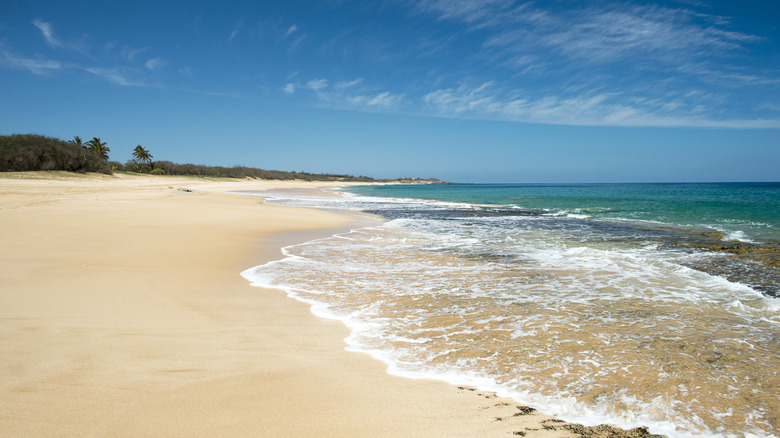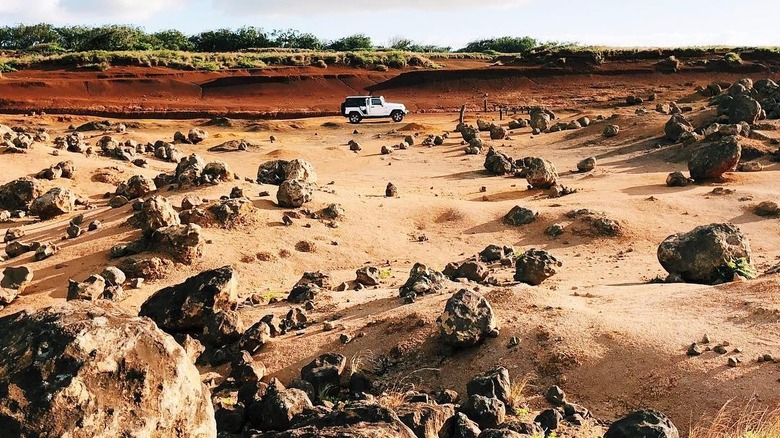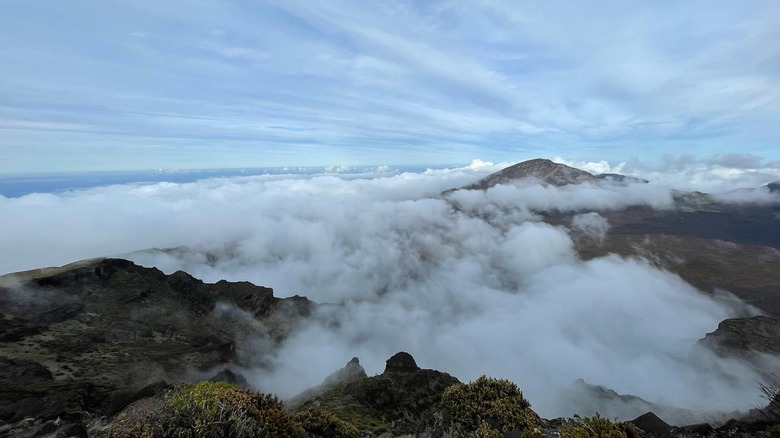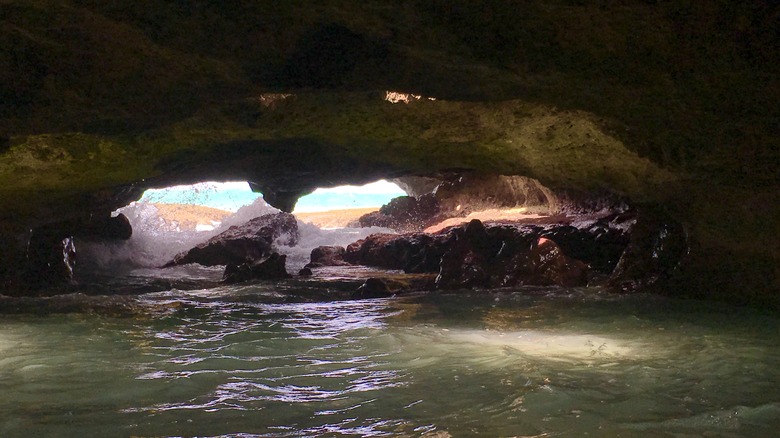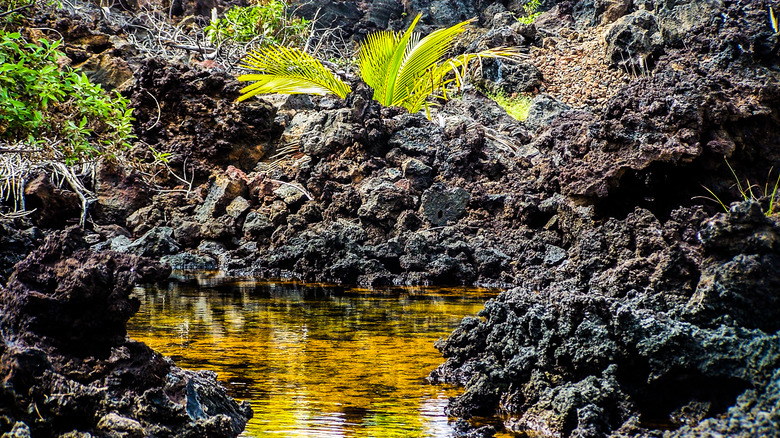14 Hidden Gems In Hawaii Only Locals Know
More than 9.2 million people visited the Hawaiian islands in 2022. It's no secret why tourists come here — the state is renowned for its spectacular Hawaiian beaches, verdant rainforests, and towering volcanoes. With so many people flocking to the islands, you might think it would be impossible to find a beautiful stretch of sand or jungle trail all to yourself. But if you know where to look, you'll find that there are still plenty of hidden gems in Hawaii.
Even if you've never been to Hawaii, you've probably heard of famous sites like Waikiki Beach, Mauna Loa volcano, and Pearl Harbor. These are some of the top sites that tourists visit and for good reason. However, if you get off the beaten track, some pretty amazing spots are just as interesting, awe-inspiring, and blissfully crowd-free. For those who want to escape the hordes, explore the underrated attractions in Hawaii that locals know and love.
Papakōlea Beach, Hawaii
There are only four beaches in the world that have green sand, and Papakōlea Beach is one of them. This unique beach is located in a cinder cone on the south coast of the Big Island. The sand gets its greenish hue from a mineral called olivine, which erodes from the cinder cone. It's not the easiest beach to get to, so that keeps some of the crowds away. Plus, there are no lifeguards on the beach, no facilities, and no shaded areas. But if you can handle the dusty hike and heat, it's a pretty special spot to experience.
To get to Papakōlea Beach, drive along South Point Road to South Point (Ka Lae) and keep going until you get to the parking lot. From here, you can hike about 2.5 miles along a dusty trail to the beach. You'll have to climb down a cliff to get to the sand below. It should be noted that there are enterprising locals who offer rides to the clifftop via off-road vehicles. However, this is actually illegal. The land leading to the cliff is loose and sandy, and off-road vehicles cause a great deal of damage to the ecosystem. For environmental purposes, it's better to hike than hitch a ride. While swimming is possible at Papakōlea, the waves can be very choppy.
Pu'u Kilea (Olowalu Petroglyphs), Maui
Maui may be best known for its beautiful beaches and lush landscapes, but hidden away on the western coast, there is an interesting site that has great historical significance. The Olowalu Petroglyphs, or Pu'u Kilea to locals, are a group of more than 100 stone carvings on basalt rocks. The figures were carved over 300 years ago and include depictions of humans, canoes, and animals. No one knows the exact meaning of the carvings, but many believe the ancient Hawaiian people were either recording stories or making visual representations of their lives.
The Olowalu Petroglyphs are relatively easy to get to if you know what to look for. From Honoapiilani Highway, you turn inland onto Luawai Street. Drive until you see a dirt road on the left, and then park next to the shed. It's just a short walk to the petroglyphs from here. You can also hike to the site on a trail that starts behind the Olowalu General Store. The trail is about a mile long and takes about 30 minutes to hike, depending on your pace.
The Blue Room, Kauai
On the island of Kauai, there is a secret cave with a pool that glows an ethereal blue hue when the sunlight hits the calcite rocks just right. You may recognize the Blue Room (also known as Waikapalae Wet Cave) from "Pirates of the Caribbean: On Strangers Tides." The cave was used as the grotto that led to the Fountain of Youth in the movie. According to local legends, the Blue Room is home to a malevolent spirit who can change shapes and has been known to take lives.
Many people who visit Haena State Park visit the Maniniholo Dry Cave, but not too many venture further to find the Waikapalae Wet Cave. It's actually not far from the Ke'e Beach overflow parking lot. You just cross the road and follow a small trail that leads down to the cave. There is a steep hill you'll have to scramble down to get to the entrance of the cave. Wade into the cool springwater pool to find the Blue Room chamber at the back of the cave. Be sure to heed any signs that warn of falling rocks or bacteria in the water.
Corsair Plane Wreck Dive Site, Oahu
Deep in the waters off the southeast coast of Oahu sits the Vought F4U-1A Corsair, a fighter plane that sank in 1945. The pilot, Lt. William H. Holden, was flying from Molokai to Oahu when he experienced mechanical problems over the ocean. He managed to land the plane on the water and escape, but the plane sank to the depths where it has sat ever since. It's mostly still intact and sits on a huge swathe of sand with nothing much else around, which makes it a pretty cool wreck to explore. Divers have reported seeing garden eels, manta rays, and frogfish around the wreck.
The dive site is not particularly hard to get to, as it's only about three miles offshore in Maunalua Bay. However, most dive companies advise that it's best for advanced divers due to the strong currents in the area. The wreck is about 100 feet below the surface, so you'll need your Advanced Open Water certification. If you're looking for more underwater places to explore, some of the other best dive sites in the area include LCU and the Kahala Barge, both of which are vessels that were intentionally sunk to create artificial reefs. The Spitting Cave is an interesting cliff wall on the far east end of the bay.
Ka'u Desert, Hawaii
The Ka'u Desert looks like something out of an apocalyptic movie with its barren, burnt-earth-looking landscape. However, it's a fascinating place to explore. The landscape is the result of previous explosions from the Kilauea Volcano, which covered the land in lava and ash. While other parts of the Hawaii Volcanoes National Park can be lush, green, and mountainous, this part of the park features broad expanses of swirled, crinkled, and hardened lava. In one area, you can see ancient footprints left in the ash.
The Ka'u Desert Trailhead is located on Highway 11 just a few miles past the entrance to the Hawaii Volcanoes National Park. You'll need to pay a fee to enter the park. The standard entrance pass is $15 per person or $30 for a private vehicle. From the highway, it's a short hike to the footprints area. Here, you can see where ancient Hawaiian people traversed the ash before it hardened. You can also keep hiking through the lunar-like environs and connect to other trails within the park. Be sure to check the park alerts because the trails are sometimes closed due to volcanic activity.
Redwood Trail, Maui
When you think of redwood trees, California probably comes to mind. But if you venture into the heart of Maui, you'll find a dense forest of these hardy conifers. The Redwood Trail in the Polipoli Springs State Recreation Area is a magical place where mist swirls through towering redwoods and Monterey pines. The trees were planted by the Civilian Conservation Corps in the 1920s and 1930s to reforest the area, and some of them are now more than 100 feet tall. The high elevation makes the area cooler than other parts of Maui, which creates the perfect growing conditions for the non-native trees.
Many tourists don't know about the Redwood Trail, so you'll likely have the trail all to yourself. To get here, take Highway 37 from Kahului, turn left at the second exit for Highway 377, and then left again on Waipoli Road. The last leg of the road to the trail is unpaved, so you'll either need a 4x4 vehicle or hike. The Redwood Trail ends at a junction where it meets the Boundary Trail and the Plum Trail. There is an old ranger's cabin near the junction that you can sleep in if you have a permit to camp overnight in the park.
Kawela Bay, Oahu
Many hidden gems in Hawaii are hidden because they're hard to get to. That's not the case with Kawela Bay. This crescent-shaped beach on the northern tip of Oahu is an easy walk from the Turtle Bay Resort or the Kamehameha Highway. Despite this, it usually only gets a handful of visitors each day. It's a great spot for families because the sand is soft and there are plenty of ironwood trees for shade. In addition, the water is calm thanks to a reef offshore that protects the bay from high waves. Snorkelers can often see sea turtles swimming in the bay.
If Kawela Bay looks slightly familiar, that's because the beach and surrounding area have been used as a filming location for several movies and TV shows. "Forgetting Sarah Marshall" was filmed at the Turtle Bay Resort, and some scenes take place at Kawela Bay. The beach at Kawela Bay and the huge banyan tree just behind the beach also appear in "Lost," "Pirates of the Caribbean: On Stranger Tides," "Hunger Games: Catching Fire," and "Soul Surfer."
Kaumana Cave, Hawaii
Hidden away in a forest on the eastern side of the Big Island lies a huge lava tube called the Kaumana Cave. It was formed when the Mauna Loa volcano erupted in 1881 and sent lava flowing almost to the town of Hilo. The top layer of the lava flow cooled first, creating a crust under which more lava continued to flow. The channel eventually emptied of lava, resulting in the Kaumana Cave. Visitors can now access the cave through a skylight and explore the chamber to see unique lava formations.
Kaumana Cave is just a 10-minute drive from Hilo along Highway 200. The parking area is between mile markers 4 and 5 on the south side of the highway. Cross the road to get to the Kaumana Caves State Park and follow the stairs down to the entrance of the cave. Once inside, there are about two miles of caves open to the public. The area around the entrance gets some light from the skylight, but it gets dark quickly further in. For better views of the lava formations, you'll want to bring a flashlight or headlamp.
Harold L. Lyon Arboretum, Oahu
If you want to take a break from the busy beaches of Waikiki, the Harold L. Lyon Arboretum is an oasis of botanical beauty just outside of Honolulu. The arboretum boasts over 6,000 species of plants spread across 200 acres in a lush valley. There are peaceful trails and gardens to explore, picnic areas, and a path that leads to a waterfall and lagoon. Even better, it's more of a locally visited spot, so it rarely gets hordes of tourists.
Nestled in the lush Mānoa Valley, the Harold L. Lyon Arboretum is just five miles from Waikiki, but it seems a world away. The tranquil trails are bursting with colorful flowers and greenery, and there are plenty of places to stop and rest or do some meditation. The arboretum is open from 9 a.m. to 3 p.m., Monday to Friday, and reservations are required. It's free to explore the gardens, although they do suggest a donation of $10. You can pick up a map of the gardens in the Visitors Center just past the main parking lot.
Papohaku Beach, Molokai
Molokai is an underrated Hawaiian island that is perfect for a crowd-free beach vacation. One stretch of sand that sees very few crowds is Pāpōhaku Beach. It's located on the west shore of Molokai and is also referred to as Three Mile Beach for its three miles of soft, white sand. The beach is also very wide, spanning about 300 feet. Although swimming is not advised, as the waves can be quite strong, it's the perfect place for taking strolls along the sand and searching for seashells. On clear days, you can see Oahu across the Kaiwi Channel.
Another appealing aspect of Pāpōhaku Beach is the wealth of amenities. The Pāpōhaku Beach Park has picnic tables, barbecues, and an ADA-accessible comfort station with restrooms, showers, and changing rooms. You can also camp at the park and fall asleep under the stars listening to the sound of the surf rolling in. You'll need a permit from the Maui County Parks & Recreation Office to camp overnight in the park. Camping permits for non-residents cost $50 per night for adults between Monday and Thursday and $100 per night on weekends.
Keahiakawelo (Garden of the Gods), Lanai
It's not easy to get to the Garden of the Gods, but if you have a 4x4 vehicle or are willing to rough the bumpy dirt road on a mountain bike, the surreal landscape is worth the journey. Red sand creates a bed for thousands of rock formations that sit 1,600 feet above sea level. It's an otherworldly place made even more special by the sweeping views of Molokai and Oahu on clear days. If you're visiting Lanai, it's worth the 45-minute drive from Lanai City to see this beautiful and sacred spot.
There are several legends about how the Garden of the Gods was formed. According to one legend, a kahuna (priest) named Kawelo had a contest with a priest from Molokaʻi to see who could keep fires burning on their islands the longest. To win, Kawelo used every tree and plant on Lanai to keep his fire burning. Keahiakawelo is the local name for the site and it means "fire of Kawelo." Scientifically speaking, the interesting rock towers and pinnacles were formed by centuries of erosion.
Leleiwi Overlook, Maui
Located in the Haleakalā National Park, the Leleiwi Overlook offers spectacular views over the Haleakalā crater and Maui's northern coast. It's an easy walk from the highway, but many people pass it by on their way to other more popular trails in the park. However, those in the know make the short hike to the overlook platform. From the edge of the crater, you can soak up views of the 3,000-foot-deep crater, which looks like it belongs on the surface of the moon. On clear days, you can also see the Hakemau'u trail winding through the landscape and the ocean in the distance.
You may find that clouds have rolled in, obscuring part of the views. But don't let that deter you. It may allow you to experience a unique natural phenomenon called The Brocken Spectre. If the sun and the clouds are in the right position and you stand with your back to the sun, your shadow on the clouds might be surrounded by a rainbow halo.
Mermaid Cave, Oahu
Swimming in the ocean and exploring caves are two of the best outdoor activities you can do in Hawaii. At the Mermaid Cave, you can do both at the same time. The cave isn't the easiest to find unless you know what to look for, so it doesn't typically get overrun with tourists. To get here, you can take Highway 93 along the west coast of Oahu and turn onto Laumania Avenue at the southern edge of Nanakuli Beach Park. Park in the parking lot, and then walk across the lava shelf towards the water until you see a hole in the rock. Climb down the hole to get into the cave.
The Mermaid Cave is a surreal spot where sunlight filters in and bathes the cave and water with a soft glow. It's best visited at low tide when the water is relatively low and calm. At high tide, the waves can push you into the sharp rocks or even pull you out to sea. Also, keep in mind that you'll need to climb back out of the hole, so it takes a bit of strength and maneuvering. Small children may have difficulty getting in and out of the cave. If you have little ones in tow, you might be better off visiting nearby Nanakuli Beach.
Golden Pools of Keawaiki, Hawaii
Behind the black sand beaches of Keawaiki Bay, there are sparkling golden pools hidden in the lava fields. The pools get their golden hue from algae that grow in them, and they're surrounded by tufts of greenery and hardened black lava. Nearby, there are also interesting sites like an ancient temple and the King's Highway foot trail, which was once a path carved out for royals to traverse. The pools aren't listed in many tourist guides, and the trek is a bit tough, so you probably won't run into too many other people on your journey to the pools.
The trailhead for the Keawaiki hike is located off Highway 19 near mile marker 79. Trek the lava field down to Keawaiki Bay and then head north to Pueo Bay. In the center of the beach, there is a trail that leads to the Golden Pools of Keawaiki. The freshwater pools are beautiful, but also host fragile ecosystems, so visitors shouldn't swim or wade in the pools. Also, be mindful that the ancient sites are sacred spots, so don't take stones or alter the area in any way. Remember that part of being a respectful tourist in Hawaii is leaving sites just the way you found them.
